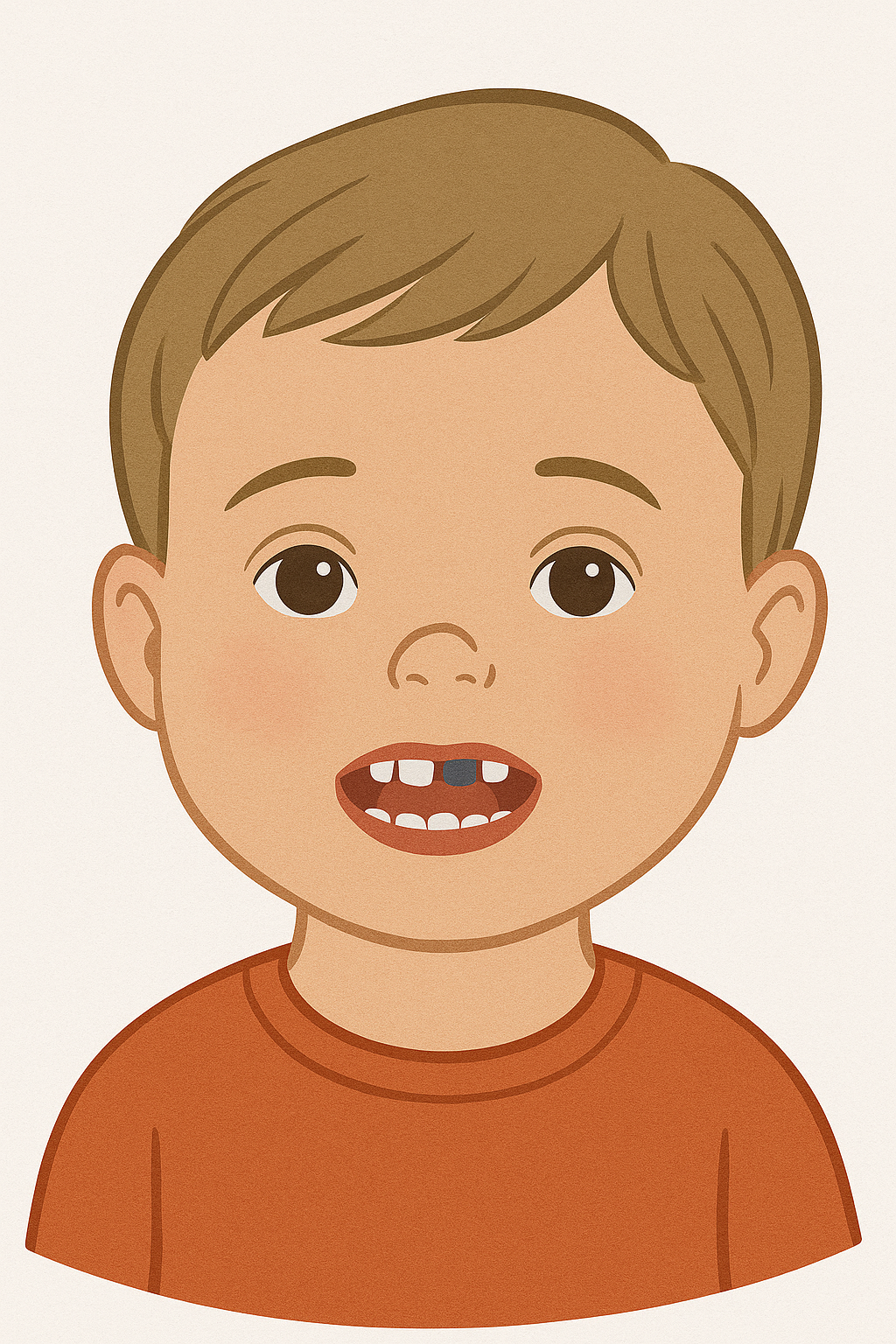It can be alarming for any parent to notice a sudden grey or discolored tooth in their toddler’s smile. At this age, every little change can raise concern—especially when it involves their health or appearance. A grey tooth in a toddler is not just a cosmetic issue; it might be a sign of trauma or underlying dental problems. This blog will walk you through the causes, available treatments, and preventive measures to help you understand and fix a grey tooth in your toddler.
What Is a Grey Tooth?

A grey tooth is a tooth that has darkened in color, often appearing grayish, purplish, or even black. This discoloration typically affects one tooth and can happen shortly after dental trauma, such as a fall or bump to the mouth—a common occurrence among toddlers learning to walk and explore.
The color change is due to internal bleeding or nerve damage in the tooth. Just as a bruise forms under the skin, the blood inside the tooth can break down and cause it to darken.
Causes of Grey Teeth in Toddlers
Understanding the root of the discoloration is essential for determining the best course of action. Here are the most common causes:
1. Dental Trauma
The number one cause of grey teeth in toddlers is physical trauma. A hard bump or fall can damage the blood vessels inside the tooth, leading to internal bleeding and discoloration. This is especially true if the tooth was not visibly chipped or broken—the damage might be invisible from the outside.
2. Tooth Decay
If the grey color develops gradually and is accompanied by bad breath or pain, it might be a sign of tooth decay or infection. Cavities can affect tooth color as the enamel breaks down.
3. Pulp Necrosis (Nerve Death)
A grey tooth can indicate that the pulp (nerve) inside the tooth has died. This condition, known as pulp necrosis, often results from untreated trauma or infection and can eventually lead to abscesses or gum swelling.
4. Congenital Factors or Medications
In rare cases, discoloration can be congenital (present at birth) or caused by medications such as tetracycline taken during pregnancy. However, these usually affect multiple teeth rather than just one.
Is a Grey Tooth in a Toddler a Dental Emergency?
Not always—but it does require attention. If your toddler shows pain, swelling, fever, or bleeding, you should call your pediatric dentist immediately. However, even without symptoms, it’s important to schedule a dental visit soon after noticing a grey tooth to prevent further complications.
What to Expect at the Dentist
Your child’s dentist will perform an examination and may take a dental X-ray to assess the condition of the inner tooth structures. Based on the findings, they may recommend:
1. Observation (Watchful Waiting)
In many cases—especially when the tooth is not painful—your dentist may recommend simply monitoring the tooth. Sometimes, the tooth may lighten again after a few months as it heals, or it may stay discolored without causing any problems until it falls out naturally.
2. Pulpotomy or Pulpectomy (Baby Root Canal)
If the tooth is infected or painful, a pulpotomy or pulpectomy may be needed. These procedures remove the damaged or dead nerve tissue inside the tooth. This is similar to a root canal but specifically for baby teeth.
- Pulpotomy removes only the upper portion of the nerve.
- Pulpectomy removes all nerve tissue if the entire pulp is damaged.
These procedures help preserve the baby tooth until it’s ready to fall out naturally, which is important for maintaining space for the permanent tooth.
3. Tooth Extraction
If the tooth is too damaged to save, or if there is a serious infection or abscess, the dentist may recommend removing the tooth. While this might seem drastic, extracting a severely damaged tooth can prevent the spread of infection to other teeth and the jaw.
Can a Grey Baby Tooth Turn White Again?
Sometimes. If the discoloration was caused by mild trauma and the nerve remains healthy, the tooth may return to a normal color over time—usually within a few weeks or months. However, if the pulp has died, the grey color is likely permanent unless treated.
How to Manage and Monitor at Home

While waiting for your dental appointment—or if your dentist has recommended monitoring the tooth—here’s what you can do at home:
- Watch for signs of infection: swelling, gum redness, pus, or a bad smell could indicate a problem.
- Avoid biting hard on that tooth: Give soft foods to reduce further trauma.
- Maintain oral hygiene: Gently brush the affected tooth to prevent decay.
- Apply cold compress if swelling appears.
- Note behavioral changes: Is your child crankier than usual or avoiding food? These might be subtle signs of discomfort.
Prevention Tips to Avoid Grey Teeth in Toddlers

1. Childproofing Your Home
Toddlers are naturally clumsy as they learn to walk and explore. Install safety gates, corner guards, and use non-slip mats to minimize falls—especially near hard surfaces.
2. Supervised Play
Keep an eye on toddlers during active play, especially when they are running around with toys or climbing furniture.
3. Use Mouthguards
For children involved in early sports or recreational activities, especially if they have already had dental trauma, a soft pediatric mouthguard can protect teeth from impact.
4. Early Dental Visits
The American Academy of Pediatric Dentistry recommends a first dental visit by age 1 or within 6 months of the first tooth eruption. Regular checkups can help monitor tooth health and detect problems early.
5. Healthy Diet
Avoid sugary snacks and drinks that can weaken enamel and lead to decay. Encourage water, milk, fruits, and vegetables to support overall oral health.
When Will the Grey Tooth Fall Out?
Most baby teeth begin to fall out between ages 6 to 7, but this can vary. A grey baby tooth typically falls out naturally with the rest—unless it needs to be extracted due to infection. Losing a baby tooth earlier than normal is not usually a major concern, but in some cases, your dentist may place a space maintainer to keep the gap open for the permanent tooth.
Emotional Reassurance for Parents
It’s natural to feel worried or even guilty when your child’s tooth changes color. But remember: toddler accidents are extremely common. A grey tooth doesn’t necessarily mean you’ve done something wrong. What matters is how quickly and thoughtfully you respond.
Final Thoughts
A grey tooth in a toddler can be unsettling, but in most cases, it’s not a medical emergency. Whether the result of trauma or infection, timely dental evaluation can prevent complications and preserve your child’s dental health. Keep a watchful eye, maintain good oral hygiene, and follow your dentist’s advice.
If your child’s grey tooth doesn’t hurt, your dentist may simply monitor it. If there are signs of infection, treatment options like pulpotomy or extraction are available to ensure long-term oral health. And remember—most of the time, baby teeth will eventually fall out, making way for a healthy set of permanent teeth.





